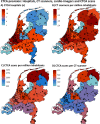The impact and challenges of implementing CTCA according to the 2019 ESC guidelines on chronic coronary syndromes: a survey and projection of CTCA services in the Netherlands
- PMID: 34921633
- PMCID: PMC8684565
- DOI: 10.1186/s13244-021-01122-2
The impact and challenges of implementing CTCA according to the 2019 ESC guidelines on chronic coronary syndromes: a survey and projection of CTCA services in the Netherlands
Abstract
Background: The 2019 ESC-guidelines on chronic coronary syndromes (ESC-CCS) recommend computed tomographic coronary angiography (CTCA) or non-invasive functional imaging instead of exercise ECG as initial test to diagnose obstructive coronary artery disease. Since impact and challenges of these guidelines are unknown, we studied the current utilisation of CTCA-services, status of CTCA-protocols and modeled the expected impact of these guidelines in the Netherlands.
Methods and results: A survey on current practice and CTCA utilisation was disseminated to every Dutch hospital organisation providing outpatient cardiology care and modeled the required CTCA capacity for implementation of the ESC guideline, based on these national figures and expert consensus. Survey response rate was 100% (68/68 hospital organisations). In 2019, 63 hospital organisations provided CTCA-services (93%), CTCA was performed on 99 CTCA-capable CT-scanners, and 37,283 CTCA-examinations were performed. Between the hospital organisations, we found substantial variation considering CTCA indications, CTCA equipment and acquisition and reporting standards. To fully implement the new ESC guideline, our model suggests that 70,000 additional CTCA-examinations would have to be performed in the Netherlands.
Conclusions: Despite high national CTCA-services coverage in the Netherlands, a substantial increase in CTCA capacity is expected to be able to implement the 2019 ESC-CCS recommendations on the use of CTCA. Furthermore, the results of this survey highlight the importance to address variations in image acquisition and to standardise the interpretation and reporting of CTCA, as well as to establish interdisciplinary collaboration and organisational alignment.
Keywords: Computed Tomography Angiography; Coronary artery disease; Guidelines.
© 2021. The Author(s).
Conflict of interest statement
The authors have no conflicts of interest to declare. All co-authors have seen and agree with the contents of the manuscript, and there is no financial interest to report. We certify that the submission is original work and is not under review at any other publication.
Figures





References
-
- Montalescot G, Sechtem U, Achenbach S, et al. 2013 ESC guidelines on the management of stable coronary artery disease: the task force on the management of stable coronary artery disease of the European Society of Cardiology. Eur Heart J. 2013;34(38):2949–3003. doi: 10.1093/eurheartj/eht296. - DOI - PubMed
LinkOut - more resources
Full Text Sources

